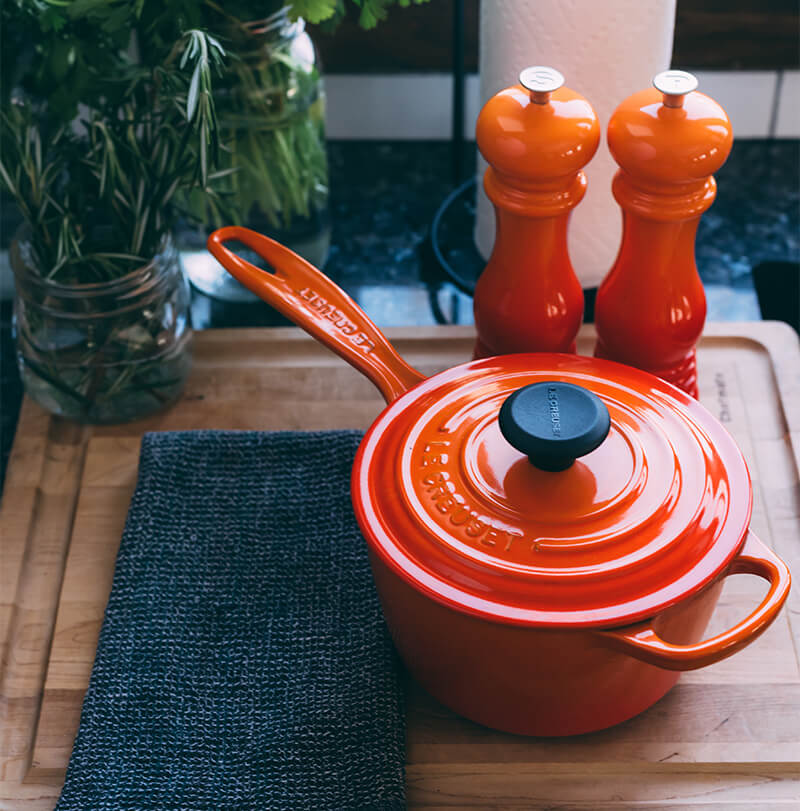
8 Healthy Cooking Appliances That Should Be in Your Kitchen
You eat a healthy ancestral diet. You put a great deal of effort into avoiding processed fare and piling your plate high with nutrient-dense, real foods. But do you give just as much thought to the how of your diet as you do the what?
The truth is, the nutrition content of your Paleo meals and snacks is just one aspect of their influence on your overall wellness. The way in which you prepare and store foods can actually make them better or worse for you. Here’s my advice on the containers and cookware to avoid and my recommendations for the healthy cooking appliances and equipment you need in your kitchen.
It’s time to throw out those nonstick pots and pans and replace them with healthier alternatives. Check out this article for eight healthy appliances and tools you should stock up on. #healthylifestyle #wellness #chriskresser
First, Clear These Health Hazards Out of Your Kitchen
Before you can stock up on the right cooking equipment, you’ve got to make room for it by clearing out the wrong stuff. It’s time to toss the following health hazards lurking in your cabinets and drawers.
Nonstick Pots and Pans
If there’s one cookware material I would never use, it’s Teflon, a plastic coating that makes pots and pans nonstick. I realize how tempting nonstick products are—they’re inexpensive and easy to clean. But I promise you the health threats they pose outweigh any time or effort they may save you in the kitchen.
Much of this risk comes from the dangerous chemical known as PFOA. Although the company behind Teflon stopped manufacturing its products with PFOA several years ago, pots and pans coated with PFOA-containing Teflon remain in use in home, commercial, and restaurant kitchens.
PFOA can leach into food. That’s scary, because in addition to environmental damage, the chemical has been linked to: (1, 2, 3, 4, 5, 6, 7, 8)
- Cancer
- Liver issues
- Thyroid disease
- Infertility and growth defects
- Immunotoxicity (damage to the immune system)
- Chronic renal disease
And here’s the rub: evidence suggests that the chemicals replacing PFOA aren’t any better. (9, 10) In 2015, hundreds of scientists signed the Madrid Statement to sound the alarm that ramping up use of PFOA alternatives will “increase the risks of adverse effects on human health and the environment.”
Plastic Containers, Wrap, and Plastic Bags
I’m sure you’ve heard about the dangers of bisphenol A, or BPA, the toxic chemical used in the manufacture of hard-plastic food containers. (It can also be found in the lining of tin cans and on receipts.) It’s been connected with type 2 diabetes, heart disease, asthma, cancer, and other diseases. (11, 12, 13, 14) BPA is an endocrine disruptor, meaning it can mimic and interfere with the body’s naturally circulating hormones, chiefly estrogen, which is especially concerning.
But it’s not the only endocrine disruptor in plastics. Phthalates are ubiquitous plasticizers that also hamper the endocrine system and can otherwise negatively impact the body. And as is the case with PFOA replacements, plastic chemical alternatives may be just as damaging as BPA and phthalates themselves. (15, 16)
In fact, one study evaluated commonly used plastic storage containers, bags, and wraps, including those labeled BPA-free. More than 90 percent of the products leached estrogenic chemicals before any testing. After being subjected to everyday “stressors” like sunlight, the microwave, and the dishwasher, nearly all of the products showed estrogenic activity. (17)
Aluminum Cookware and Aluminum Foil
Aluminum cookware has been proven to leach a significant amount of the metal into food during cooking, and the migration of aluminum into foods from aluminium foil has been shown to exceed suggested limits set by the World Health Organization. (18, 19, 20, 21) Acidic foods, including tomatoes and citrus, seem to absorb the most aluminum.
A known neurotoxin, aluminum appears to reduce the growth of brain cells and may play a role in the development of Alzheimer’s disease. (22, 23, 24) It may also damage the kidneys and weaken bones. (25, 26)
Get Cooking: Six Healthy Cooking Tools You Need to Stock Up On
Now that you know what not to use for cooking and storing your nutritious ancestral meals, here’s what you should do when it comes to healthy cooking appliances and equipment.
1. Enamel Cookware—The Least Reactive Choice
Enamel-coated cookware, also called porcelain enamel, is one of the safest types of cookware that comes close to being nonstick, making it easy to use and a cinch to clean.
The cooking surface—glass particles bonded to metal at high temperatures—is nonreactive, so there’s no need to worry about dangerous chemicals or metals leaching into your food. The best quality can be found in enameled cast iron, but enameled ceramic or steel are other great choices.
Though it can take a little longer for enamel cookware to heat up (compared to nonstick varieties), the heat is distributed evenly and is easily maintained, making it a versatile cookware material for many types of dishes. Enamel pots and pans can also easily and safely go from stovetop to oven for slow cooking or braising.
Enamel cookware tends to be expensive, but high-quality enamel pots and pans are extremely durable and will last many years. My top picks are by Le Creuset: the 5 1/2-Quart Round French Oven and the Stoneware Square Baking Dish.
2. Stainless Steel for an Affordable, Durable Option
As with enamel, stainless steel is stable and unlikely to leach. The metal is affordable, durable, and can be used for any type of cooking. Though it doesn’t distribute heat as evenly as enamel, it is especially useful for throwing together quick sautés, browning meat, and making broths and sauces. Most stainless pots and pans can withstand dishwashers and abrasive cleansers without scratching or denting, so clean up is relatively painless.
That said, they can be prone to sticking. To minimize that problem, preheat before cooking—and use adequate oil.
Be sure to purchase stainless cookware without a nonstick coating. My favorite stainless steel items are by All-Clad: the Stainless 10-Inch Fry Pan and the Stainless Steel 1 1/2-Quart Sauce Pan with Lid.
3. Cast Iron—Unless You Have Iron Overload
If you have iron overload, you may want to avoid cast iron skillets, since they can leach inorganic iron, particularly when used to cook acidic ingredients. However, the amount they release is generally safe if you don’t have any issues with excess iron.
Cast iron is durable and provides great conductivity and heat retention. It is perfect for cooking dishes that need to go from stovetop to oven and is excellent for searing meat. Cast iron tends to be far less expensive than enamel, but lasts just as long.
Note that cast iron cookware does require some extra effort in its maintenance. Popular cast iron cookware items are Lodge’s Pro-Logic 10-Inch Chef’s Skillet and 10.5-Inch Square Cast Iron Grill Pan.
4. Glass for Baking and Reheating
Use glassware—or cast iron or enamel—for baking or reheating. And for storage, opt for glass containers and canning jars. Just be aware that the lids of Mason and Kerr brand canning jars contain BPA and other estrogenic chemicals. The brand Weck makes 100 percent glass jars that are a good alternative.
5. Parchment Paper for Wrapping Foods
Instead of conventional plastic wrap, choose unbleached parchment paper or beeswax-coated reusable food wrap (such as Bee’s Wrap) to store your cut vegetables and other foods.
6. Silicone Storage (Instead of Plastic Bags)
Swap plastic sandwich and freezer bags with reusable silicone storage options (such as Stasher bags). You can also use stainless steel containers, as well as certain glass options, in the freezer.
Two More Helpful, Healthy Cooking Appliances
These healthy cooking appliances also deserve a place in your kitchen.
1. Instant Pot
Slow cookers have been around for decades, and I’ve used them myself for years. I still recommend them, as they’re a great tool for Paleo meal prepping. You can easily (almost effortlessly) make big batches of chicken, turkey, beef, bison, or game meat for later use in stir-fries, salads, stews, and other dishes.
But as Paleo cookbook author Michelle Tam shared on an episode of Revolution Health Radio, if you can slow-cook something, you can cook it in a pressure cooker—much more quickly. If you have the funds to add an Instant Pot to your arsenal, I highly recommend it. This next-generation programmable pressure cooker is safe and convenient, has a stainless steel insert, and is a game-changer for braising cheaper cuts of meat.
2. Microwave Oven
I doubt you expected to see this appliance listed. After all, “nuking” your foods just sounds frightening. But most research concludes that low-level microwave exposure doesn’t present a significant risk to human health. (27, 28, 29) And even if it did, it would only be an issue if the microwaves inside the oven somehow escaped the appliance and encountered your body, which is highly unlikely. Not to mention, compared with microwave radiation from other devices (namely cell phones), radiation from your microwave oven is negligible. If you’re concerned, to avoid any potential radiation from your microwave, all you have to do is step away from it while your food is heating. Additionally, there’s no evidence that microwaves adversely affect the nutrient profile of foods.
Microwave use really comes down to personal preference. If having access to a quick, convenient reheating method makes the difference between eating a nutrient-dense, healthy meal or a processed snack, don’t be afraid to use one.
Do you have any of these cooking products in your kitchen? Comment below and share your go-tos when it comes to healthy cooking.






